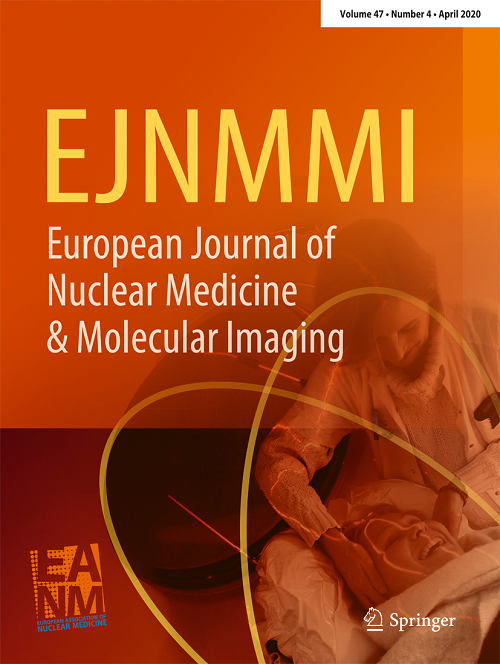Validation of novel low-dose CT methods for quantifying bone marrow in the appendicular skeleton of patients with multiple myeloma: initial results from the [18F]FDG PET/CT sub-study of the Phase 3 GMMG-HD7 Trial.
IF 7.6
1区 医学
Q1 RADIOLOGY, NUCLEAR MEDICINE & MEDICAL IMAGING
European Journal of Nuclear Medicine and Molecular Imaging
Pub Date : 2025-10-01
DOI:10.1007/s00259-025-07599-z
引用次数: 0
Abstract
PURPOSE The clinical significance of medullary abnormalities in the appendicular skeleton detected by computed tomography (CT) in patients with multiple myeloma (MM) remains incompletely elucidated. This study aims to validate novel low-dose CT-based methods for quantifying myeloma bone marrow (BM) volume in the appendicular skeleton of MM patients undergoing [1⁸F]FDG PET/CT. MATERIALS AND METHODS Seventy-two newly diagnosed, transplantation eligible MM patients enrolled in the randomised phase 3 GMMG-HD7 trial underwent whole-body [18F]FDG PET/CT prior to treatment and after induction therapy with either isatuximab plus lenalidomide, bortezomib, and dexamethasone or lenalidomide, bortezomib, and dexamethasone alone. Two CT-based methods using the Medical Imaging Toolkit (MITK 2.4.0.0, Heidelberg, Germany) were used to quantify BM infiltration in the appendicular skeleton: (1) Manual approach, based on calculation of the highest mean CT value (CTv) within bony canals. (2) Semi-automated approach, based on summation of CT values across the appendicular skeleton to compute cumulative CT values (cCTv). PET/CT data were analyzed visually and via standardized uptake value (SUV) metrics, applying the Italian Myeloma criteria for PET Use (IMPeTUs). Additionally, an AI-based method was used to automatically derive whole-body metabolic tumor volume (MTV) and total lesion glycolysis (TLG) from PET scans. Post-induction, all patients were evaluated for minimal residual disease (MRD) using BM multiparametric flow cytometry. Correlation analyses were performed between imaging data and clinical, histopathological, and cytogenetic parameters, as well as treatment response. Statistical significance was defined as p < 0.05. RESULTS At baseline, the median CTv (manual) was 26.1 Hounsfield units (HU) and the median cCTv (semi-automated) was 5.5 HU. Both CT-based methods showed weak but significant correlations with disease burden indicators: CTv correlated with BM plasma cell infiltration (r = 0.29; p = 0.02) and β2-microglobulin levels (r = 0.28; p = 0.02), while cCTv correlated with BM plasma cell infiltration (r = 0.25; p = 0.04). Appendicular CT values further demonstrated significant associations with PET-derived parameters. Notably, SUVmax values from the BM of long bones were strongly correlated with both CTv (r = 0.61; p < 0.001) and moderately with cCTv (r = 0.45; p < 0.001). Patients classified as having increased [1⁸F]FDG uptake in the BM (Deauville Score ≥ 4), according to the IMPeTUs criteria, exhibited significantly higher CTv and cCTv values compared to those with Deauville Score <4 (p = 0.002 for both). AI-based analysis of PET data revealed additional weak-to-moderate significant associations, with MTV correlating with CTv (r = 0.32; p = 0.008) and cCTv (r = 0.45; p < 0.001), and TLG showing correlations with CTv (r = 0.36; p = 0.002) and cCTv (r = 0.46; p < 0.001). Following induction therapy, CT values decreased significantly from baseline (median CTv = -13.8 HU, median cCTv = 5.2 HU; p < 0.001 for both), and CTv significantly correlated with SUVmax values from the BM of long bones (r = 0.59; p < 0.001). In parallel, the incidence of follow-up pathological PET/CT scans, SUV values, Deauville Scores, and AI-derived MTV and TLG values showed a significant reduction after therapy (all p < 0.001). No significant differences in CTv, cCTv, or PET-derived metrics were observed between MRD-positive and MRD-negative patients. CONCLUSIONS Novel CT-based quantification approaches for assessing BM involvement in the appendicular skeleton correlate with key clinical and PET parameters in MM. As low-dose, standardized techniques, they show promise for inclusion in MM imaging protocols, potentially enhancing assessment of disease extent and treatment response.验证用于量化多发性骨髓瘤患者阑尾骨骼骨髓的新型低剂量CT方法:来自3期GMMG-HD7试验[18F]FDG PET/CT亚研究的初步结果。
目的在多发性骨髓瘤(MM)患者阑尾骨骼CT检查中发现髓质异常的临床意义尚不完全清楚。本研究旨在验证一种新的基于低剂量CT的方法,用于定量MM患者接受[1⁸F]FDG PET/CT检查时阑尾骨骼骨髓瘤骨髓(BM)体积。材料和方法纳入随机化3期gmg - hd7试验的72例新诊断、符合移植条件的MM患者在治疗前和诱导治疗(isatuximab +来那度胺、波特佐米和地塞米松或来那度胺、波特佐米和地塞米松)后接受了全身[18F]FDG PET/CT。采用医学成像工具包(MITK 2.4.0.0, Heidelberg, Germany),采用两种基于CT的方法量化阑末骨骼的BM浸润:(1)人工入路,计算骨管内最高平均CT值(CTv)。(2)半自动方法,基于整个阑尾骨骼CT值的总和来计算累积CT值(cCTv)。PET/CT数据通过视觉和标准化摄取值(SUV)指标进行分析,应用意大利骨髓瘤PET使用标准(推动力)。此外,使用基于人工智能的方法自动从PET扫描中获得全身代谢肿瘤体积(MTV)和病变总糖酵解(TLG)。诱导后,使用BM多参数流式细胞术评估所有患者的最小残留病(MRD)。影像学数据与临床、组织病理学、细胞遗传学参数以及治疗反应之间进行相关性分析。p < 0.05为差异有统计学意义。结果基线时,人工CTv的中位数为26.1 Hounsfield单位(HU),半自动CTv的中位数为5.5 HU。两种基于ct的方法与疾病负担指标均表现出微弱但显著的相关性:CTv与脑浆细胞浸润相关(r = 0.29, p = 0.02), β2-微球蛋白水平相关(r = 0.28, p = 0.02), cCTv与脑浆细胞浸润相关(r = 0.25, p = 0.04)。阑尾CT值进一步显示了与pet衍生参数的显著相关性。值得注意的是,长骨BM的SUVmax值与CTv有很强的相关性(r = 0.61, p < 0.001),与cCTv有中度相关性(r = 0.45, p < 0.001)。根据动力标准,BM中[1⁸F]FDG摄取增加的患者(多维尔评分≥4),与多维尔评分<4的患者相比,CTv和cCTv值明显更高(两者的p = 0.002)。基于人工智能的PET数据分析显示,MTV与CTv (r = 0.32, p = 0.008)和cCTv (r = 0.45, p < 0.001)相关,TLG与CTv (r = 0.36, p = 0.002)和cCTv (r = 0.46, p < 0.001)相关。诱导治疗后,CT值较基线显著下降(中位CTv = -13.8 HU,中位cCTv = 5.2 HU,两者均p < 0.001), CTv与长骨BM的SUVmax值显著相关(r = 0.59, p < 0.001)。同时,治疗后随访病理PET/CT扫描的发生率、SUV值、多维尔评分、人工智能衍生的MTV和TLG值均显著降低(均p < 0.001)。在mrd阳性和mrd阴性患者之间,CTv、cCTv或pet衍生指标无显著差异。新的基于ct的量化方法评估脑转移累及阑尾骨骼与MM的关键临床和PET参数相关。作为低剂量、标准化的技术,它们有望纳入MM成像方案,潜在地增强对疾病程度和治疗反应的评估。
本文章由计算机程序翻译,如有差异,请以英文原文为准。
求助全文
约1分钟内获得全文
求助全文
来源期刊
CiteScore
15.60
自引率
9.90%
发文量
392
审稿时长
3 months
期刊介绍:
The European Journal of Nuclear Medicine and Molecular Imaging serves as a platform for the exchange of clinical and scientific information within nuclear medicine and related professions. It welcomes international submissions from professionals involved in the functional, metabolic, and molecular investigation of diseases. The journal's coverage spans physics, dosimetry, radiation biology, radiochemistry, and pharmacy, providing high-quality peer review by experts in the field. Known for highly cited and downloaded articles, it ensures global visibility for research work and is part of the EJNMMI journal family.

 求助内容:
求助内容: 应助结果提醒方式:
应助结果提醒方式:


